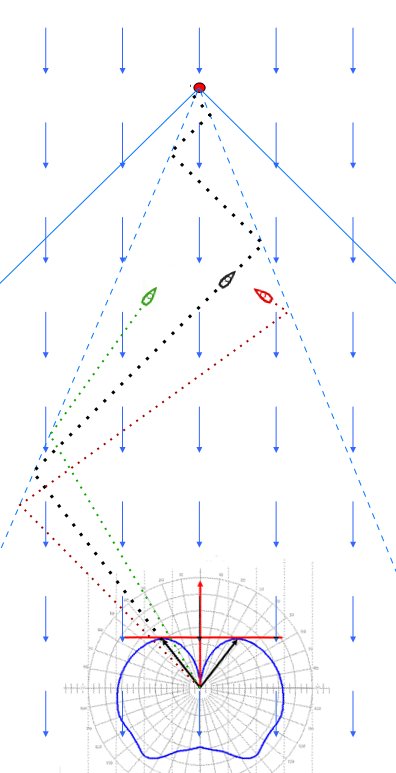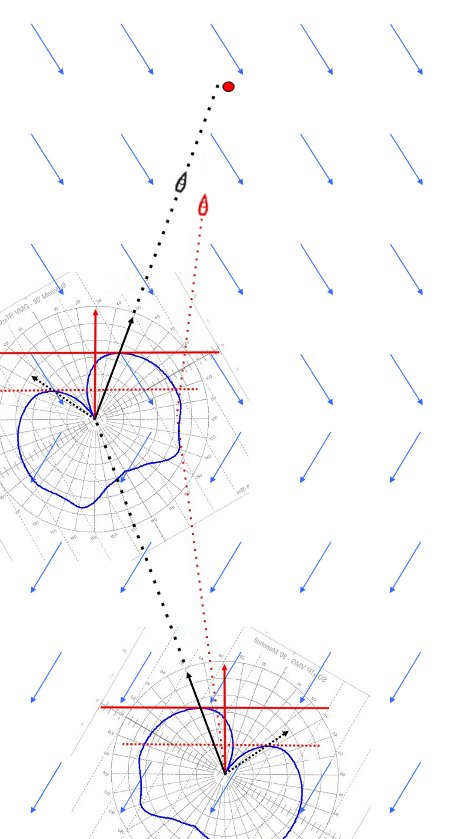So what is this VMC business? We’ll stick to a simple upwind case for now, but remember that VMC is just a way to measure your speed toward a certain goal. A relatively common question on SOL is to ask why some boats are sailing “upwind” a little bit below the proper tacking angles as indicated by VMG. The explanation usually offered is that the boats that are footing aren’t trying to get to windward, but are sailing as fast as possible toward their goal, which is usually the next shift. VMC might enter the discussion. Occasionally, someone with years of race experience chips in to explain that there’s no such thing as VMC on “pure upwind” legs, or that you never see the pro boats footing. It is easy to understand the following:
Black is sailing VMG and has no trouble pulling away from Red, who is footing, or Green pinching. Upwind on most boats, you steer to your telltales and tack on headers, and at first glance this is what is guaranteed fastest. You can see the loss in distance that either boat not on the proper tacking angle is incurring just by looking at the polar. Max VMG is the furthest point forward… anything else is slow to windward. Though the footing boat might feel fast, it’s common knowledge that he’ll lose out in the end.
The problem is that “pure upwind” sailing doesn’t exist in the real world and rarely online. Once you introduce any variation in the wind the decision is no longer as simple as VMG. Why don’t we see the big boats footing? Well… you do if you know what to look for. Often the difference between VMG and VMC angles is a degree or so. That’s sheets cracked a quarter inch, or letting the tails of the leeward ticklers lift just a bit on a puff… Where it really comes into play is offshore, over long time periods. Boats with wide polars like those of a typical multihull benefit more.
Here is the same diagram we used for VMG, but with VMC relative to a 0° target indicated. The target is not usually going to be the mark. This scenario is set up to show a really clear-cut case.
The red track is our VMG boat, tacking on the same TWA 37° as in the no-shift example. Black is sailing angles of 50° TWA, a pretty healthy ways below Red’s track. Black is clearly sailing faster, but he’s losing ground to windward, just like Red did in the first example. How can he get away with it?
Fast forward to the all-important shift. Not only is black going to get to it first, but look at what happens to the “distance to windward” measurement once both boats are in the new wind. Black is instantly both further upwind (dramatically so, in this example) but also further up-course. He happily tacks over onto port and can lay the mark on the same fast 50° angle while Red can just barely lay it at all. Red is going to get rolled to windward – Black seemingly came out of nowhere.
The red target lines and “ladder rung” maximum VMC lines allow you to visualise what is happening. In these 30 degree shifts, maximum VMC is around a knot faster toward the average wind than VMG. The boat more than makes up for the extra distance sailed by sailing with almost two knots more boatspeed. Sailing VMC upwind usually, but not always takes the form of footing on the favoured tack, but if you were stuck for some reason, you can see from the polars that best VMC for the bad tack is a (some would say crazy) 27° or so – sailing slowly but not getting swept further off track…


Hi again.
‘The target is not usually going to be the mark.’
Can you explain this more in deep? I don’t completely understand why are you doing this. Where is the target then?
Keep the good work.
Best regards
Iñaki (DeBilbaoPues)
More to come later! You normally set your target to take into account the expected windshifts up the leg, working out a sort of average wind that you’ll be sailing in. In the example, I’ve made the two tacks equal in length and the wind “symmetric” to try to keep the effects (hopefully) a little easier to grasp for now. The target here is 0 degrees.
Ok, I understand… or I think so 🙂
That’s where my navigation is weak: choosing the right waypoint. I hope you’ll help me to understand 🙂
Best regards,
Iñaki (DeBilbaoPues)
Thanks for a very instructive and enlightening post. I learned a lot. i even think I understand!
elonaeus /Erland Lonaeus
Very intersting!
What happens if the shift in the example above is less than 15 degrees, so that the starboard tack still is the favoured one. Is the usual VMG sailing best then or can you find some other “VMC” angle that will be the fastest?
/Mats
You will find another VMC angle Mats… as 76T mentions VMG is really only optimum when the CC to the waypoint is either TWD or TWD+180.
An example: in the mini 6.5, with a 15kt @ 0, maximum VMG = 4.43kt @ 34.43 [5.37kt BS], and if the CC to next mark is 8, then Max VMC = 4.82kt @ 36.07 [5.46kt].
Note: if the angle for max VMG differs in your SOL client than here, it is due to rounding, ie you will notice a range of angles with the same VMG however this is only to the 2 displayed decimal places (and my calculation is based on a 64bits of precision)
Thanks 76T for for your explanation. I understand that footing is faster than sailing VMG when there are shifts. The challenge to me is the question, how much do you foot ? No doubt the answer varies depending on a number of factors – eg. how many degrees is the windshift. Is there a rule of thumb that you use ?… ie if a shift is 10 degrees, should I foot off by 5 degrees (from Max VMG angle). In Real life and the game itself, all of this is made more complex with often diminishing wind strength, different polars, curved predictor lines, shifts moving etc.
Thanks for this post, but I’m not shure, if I get that right. My question:
I’m sailing upwind (lets say AWA of 25 inicated, boat speed Is at 6.0 kn, I have already a clear view on the next course mark.
The question I have – is there a simple funktion witch gives me the best heading to tack?
Thanks